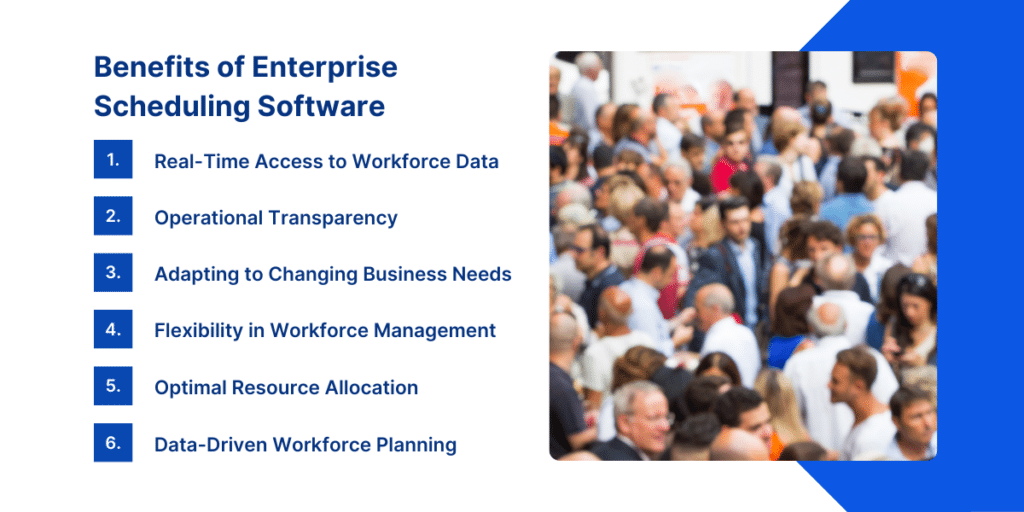This is part 2 of our Enterprise series. Part 1 explored why enterprises need to centralize their workforce management processes to properly scale.
With employees scattered across different states—or even countries—enterprises need to make sure every facility is compliant with varying regulations and can respond to different shifts in market demands.
Choosing the right enterprise scheduling software is critical for maintaining operational efficiency, ensuring compliance, and managing labor costs effectively. It’s impossible to do this without one due to the challenges below.
Challenges With Disparate Systems and Paper Processes
Data Silos
Fragmented Data Management
Utilizing multiple systems across various departments or geographic locations can create significant challenges in data coherence and visibility. Fragmented data management emerges when each segment of the organization operates its own data system with little to no integration.
This fragmentation obstructs the ability to perform comprehensive analyses and gain complete insights into organizational performance. It complicates tasks such as aggregating data for enterprise-wide reports or balancing workforce loads across peak and off-peak shifts, which are critical for making informed strategic decisions.
Barriers to Communication and Collaboration
When data is not centralized, it poses substantial barriers to effective collaboration across departments. Departments that operate in silos with their own sets of data find it challenging to align their efforts toward common organizational goals. This lack of a unified data repository can lead to misinformed decision-making and inconsistencies in executing company-wide initiatives.
The absence of accessible, centralized data can delay production and task timelines as teams spend additional time reconciling data from different sources to get a complete picture, thereby impacting overall strategic planning and execution.
Inefficiency and Errors
Operational Delays and Redundancies
The lack of uniformity in data handling across disparate workforce management systems can significantly impede operational efficiency. When different departments or locations use non-integrated systems, data must often be entered multiple times into separate systems—a process prone to delays and redundancies. This repetitive data entry not only wastes valuable time and resources but also increases the likelihood of human error.
When decision-makers lack immediate access to consolidated data, they face delays in responding to changes or opportunities. This slows down the entire operational workflow and hinders the organization’s ability to react swiftly to market or internal demands.
Error Propagation
Inconsistencies across different systems can cause a cascade of errors that affect critical aspects of workforce management such as scheduling, payroll, and resource allocation. For instance, if an employee covers a shift that they normally wouldn’t be working for a sick coworker, their hours may be captured in the time and attendance system but not be properly synced with payroll. If the payroll department is using the pre-planned schedule to reconcile their financials, this will lead to incorrect payroll processing. This results in employee dissatisfaction and potential legal issues.
Similarly, errors in scheduling data can lead to under or overstaffing, which directly impacts operational costs and efficiency. The accumulation of these errors can be compounded over time and across the enterprise, leading to significant financial and reputational damage.
Compliance Risks
Regional Variability in Labor Laws
Enterprises operating in multiple regions face significant challenges in complying with diverse local labor laws, which can vary greatly in terms of overtime, minimum wage, rest breaks, and other employment conditions. When different systems are used across these regions, each configured according to local practices but not standardized across the enterprise, it becomes exceedingly difficult to ensure uniform compliance.
This lack of uniformity can lead to inadvertent violations of labor laws, as updates to legislation or regulations may not be simultaneously reflected across all systems. For instance, if a region changes its overtime calculation rules but the local workforce management solution isn’t promptly updated, it could result in non-compliance and potential fines.
Audit and Reporting Complications
Discrepancies in data and the absence of standardized reporting protocols across disparate systems pose substantial risks during compliance audits and legal reporting. Auditors require precise and uniform data—typically going as far back as three years—to verify compliance with labor laws and other regulatory requirements. When data is inconsistent, the audit process becomes more complex, time-consuming, and prone to errors.
These complications can lead to delayed audit conclusions, increased audit costs, and even financial penalties if discrepancies suggest non-compliance. Furthermore, preparing compliance reports becomes a labor-intensive process requiring additional reconciliation efforts to ensure accuracy, diverting resources from other critical functions.

Benefits of Enterprise Scheduling Software
Enhanced Information Sharing
Real-Time Access to Workforce Data
The ability to access up-to-date workforce data at any moment is invaluable. Real-time access to information such as employee attendance and supply chain demand planning enables managers to make informed decisions quickly, ensuring that operational needs are met efficiently. Imagine a large manufacturing company that experiences a sudden surge in demand due to an unexpected influx of orders during a typically off-peak time. Without real-time access to workforce data, schedulers and frontline managers might struggle to react quickly, causing production delays. However, with an enterprise scheduling software, you can instantly access up-to-date data on employee availability, skills and competencies, and workload distribution.
This immediacy helps in managing unexpected changes, such as sudden employee absences or surges in demand, by allowing timely adjustments to staffing and resource allocation. Real-time data access facilitates proactive management practices, such as predicting potential issues before they become disruptive, enhancing overall operational readiness and responsiveness.
Operational Transparency
Centralizing data within an enterprise scheduling software fosters a culture of transparency within the organization. With all relevant data stored in a single, accessible platform, stakeholders at various levels—from floor managers to executive leadership—can have a unified view of workforce metrics. This transparency not only simplifies the monitoring and analysis of team performance but also enhances accountability as every change or adjustment is recorded and traceable.
Such an environment promotes trust and integrity within the organization, as employees know that decisions on important opportunities like overtime are made based on clear and accessible data. The ability to quickly respond to shifts in business conditions, supported by transparent and readily available data, not only optimizes daily operations but also supports strategic planning and risk management.
Scalability and Flexibility
Adapting to Changing Business Needs
A unified enterprise scheduling software is inherently designed to accommodate changes in business scale—whether that’s expansion, contraction, or diversification. The right solution provides dynamic scalability, which means they can adjust to increased loads without the need for manual intervention or significant investment in new infrastructure. For example, as a business grows and hires more employees, a cloud-based workforce management system can effortlessly handle the addition of new users and increased data volumes.
Similarly, if a business needs to downsize, the system can scale down accordingly without leaving redundant resources. This ability to dynamically scale helps organizations maintain operational efficiency and cost-effectiveness throughout different phases of business growth or market cycles.
Flexibility in Workforce Management
Flexibility is another critical advantage of one unified system. Businesses can quickly adapt their workforce strategies to respond to fluctuating market demands, seasonal peaks, or unexpected events such as a pandemic or economic downturn. For example, during the holiday season, government agencies like the Postal Service might need to increase their temporary labor headcount to handle the increased shopping activity.
An enterprise scheduling software can facilitate this by enabling quick adjustments to scheduling, shift swapping, and overtime management—all without disrupting ongoing operations. Additionally, in unexpected situations like a sudden market opportunity or a crisis, having a flexible system allows companies to rapidly reconfigure their workforce deployment, ensuring they are always optimally staffed to handle the current conditions.
Improved Labor Matching
Optimal Resource Allocation
An enterprise scheduling solution significantly enhances the capability to match labor resources with production requirements effectively, ensuring optimal utilization of the workforce. The system enables managers to view real-time data on workforce availability, skills and competencies, and workload distribution across the entire organization. By having access to such comprehensive data, managers can allocate labor resources where they are most needed, thus minimizing instances of underutilization where employees may not have enough tasks or overexertion where employees are overwhelmed with work.
For example, in a manufacturing setting, if a particular production line experiences an unexpected increase in order volume, the system can immediately identify and redeploy staff from other underutilized areas. This ensures balanced workload distribution and maintains productivity without the need to rely on overtime expenses.
Data-Driven Workforce Planning
Leveraging data for workforce planning is one of the core strengths of enterprise scheduling software. With access to historical data on workforce performance, demand cycles, and other operational metrics, businesses can use predictive analytics to forecast future labor needs with high accuracy. This forecasting capability allows for strategic scheduling that aligns employee availability with anticipated demand, thereby maximizing productivity and minimizing costs.
Preemptive scheduling not only ensures that your facility is adequately staffed to handle peak times but also avoids overstaffing during slower periods, optimizing labor costs and enhancing service quality.

Choose Indeavor as Your Scheduling Software
Indeavor offers a scalable and integrated solution that addresses all these needs with precision and flexibility, making it an ideal choice for enterprises looking to optimize their workforce management strategies.
A scalable, integrated solution is essential for enterprises that operate on a large scale or are poised for growth. Indeavor adapts effortlessly to changes in business size and complexity without compromising on performance or efficiency. The platform excels in this area by providing seamless functionality that can expand or contract based on your business demands. This adaptability ensures that enterprises can manage their workforce effectively, regardless of how their business needs evolve over time.
One of the standout features of Indeavor’s enterprise scheduling software is its superior capability to match labor with production demands accurately. It uses algorithms and real-time data to ensure that every shift is optimally staffed. This precision in staffing prevents the common pitfalls of understaffing, which can lead to burnout and decreased productivity, or overstaffing, which unnecessarily inflates labor costs. With Indeavor, you can be confident that your staffing levels are finely tuned to meet your operational needs precisely, maximizing efficiency and reducing waste.
If you’re seeking a robust, reliable, and responsive workforce management solution, consider Indeavor as your go-to platform. Our enterprise scheduling software offers unmatched scalability and precision in labor management, making it the ideal choice for enterprises aiming to streamline their operations and enhance productivity.
Don’t let workforce management challenges hold your business back.







